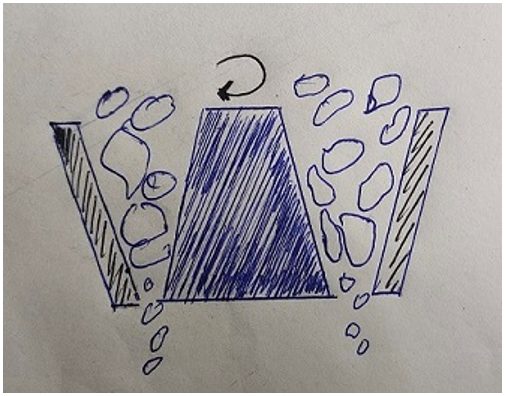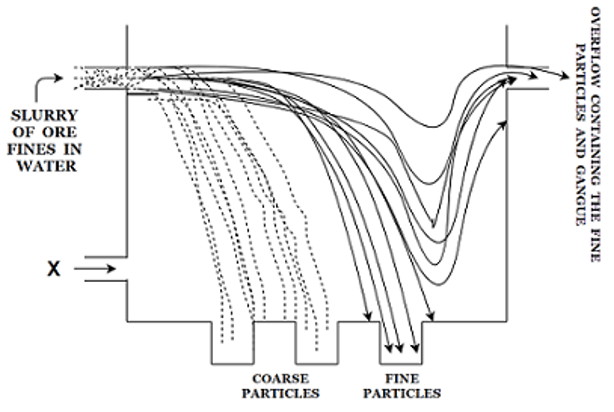This set of Extractive Metallurgy Multiple Choice Questions & Answers (MCQs) focuses on “Mineral Dressing – Set 2”.
1. A process by which particles of different sizes and specific gravities are sorted out into uniform groups is known as ______
a) separation
b) classification
c) concentration
d) capacity
View Answer
Explanation: Classification is normally applicable to a very low range of particle size and it separate particles based on their densities. Different specific gravities are the controlling factor in classification.
2. ‘Classification’ depends on the settling rates of individual particles in a fluid medium. Free settling takes place when individual particles settle freely.
a) True
b) False
View Answer
Explanation: The statement is true. Free settling takes place when individual particles are unhindered by other particles through a medium of still water or against a rising current of water.
3. Which type of settling occurs when particles of different sizes, gravities and shapes are sorted in a rising current of water?
a) Free settling
b) Drag settling
c) Unhindered settling
d) Hindered settling
View Answer
Explanation: Hindered settling occurs when sorting of particles of different sizes, gravities and shapes in a rising current of water. The velocity of this water is less than the settling rate of the particles.
4. What happens to the settling rate in ‘Classification’ process if particles have mutual magnetic attraction?
a) Settles faster
b) Settles slower
c) Settling rate does not change
d) Settling decreases for some amount of time
View Answer
Explanation: Magnetism has an impact on the settling rate. Particles having a mutual magnetic attraction settle faster compared to those not having such an attraction.
5. The separation of a valuable mineral from the gangue is known as ______
a) magnetic separation
b) classification
c) magnetic concentration
d) heavy media separation
View Answer
Explanation: The separation of a valuable mineral from the gangue is known as magnetic separation whereas the separation of one mineral from another, based on the difference in the values of the magnetic attractability of the minerals, is known as magnetic separation. Heavy media separation is a concentration which depends exclusively on the specific gravity of a particle.
6. What type of crusher is shown in the figure below?

a) Jaw crusher
b) Roll crusher
c) Gyratory crusher
d) Cone crusher
View Answer
Explanation: Gyratory crusher’s concept is similar to jaw crusher. It consists of a concave surface and a conical head. The inner cone has slightly circular movement, but it does not rotate. The movement of the gyratory crusher is generated by an eccentric movement.
7. In which beneficiation technique does an ore pulp is agitated and the air is blown through it to produce froth?
a) Floatation
b) Electrostatic separation
c) Magnetic separation
d) Sizing
View Answer
Explanation: In Floatation or Froth Floatation process, some mineral particles attach themselves to the air bubbles and are concentrated in the froth, after which they are skimmed timely. The gangue materials sink to the bottom.
8. Which of the following materials are not used for Floatation technique?
a) Pulp
b) Frother
c) Activator
d) Feed
View Answer
Explanation: Some of the materials or chemicals which are used in the Floatation process are pulp, frother, collector, activator, depressor etc. The slurry in the froth floatation process is commonly called pulp. Frother is used to stabilize the foam in the floatation method. Similarly, different materials have different functions in the floatation technique except feed.
9. Floatation depends on degree of ______
a) hardness
b) wettability
c) hotness
d) sinkness
View Answer
Explanation: We must have seen or heard that water sticks to glass but Mercury doesn’t. This is due to the degree of wettability. Some type of adhesive or cohesive forces between solid and liquid is responsible for the determination of the degree of wettability.
10. The figure shown below is a simple sluice box classifier. Determine ‘X’ shown in the diagram.

a) Air pressure control
b) Water pressure control
c) Feed
d) Underflow
View Answer
Explanation: Water pressure control is present at the bottom of the simple sluice box classifier. Simple sluice box classifier is used to separate coarse and finer particles from the slurry of the ore fines in water.
11. A reagent that enhances or modifies the surface properties of the minerals by being adsorbed is known as ______
a) pulp
b) collector
c) depressor
d) activator
View Answer
Explanation: Selective flotation is achieved using collector reagent. The differences in the surface properties of the minerals are enhanced using a reagent which is called ‘Collector’.
12. The process in which we obtain big lumps from smaller particles through a fusion of particles is known as ______
a) Dewatering
b) Coagulation
c) Floatation
d) Agglomeration
View Answer
Explanation: During Agglomeration, we observe solid-solid interaction between the particles through adhesion or fusion of particles to achieve bigger lumps from smaller particles. Types of Agglomeration techniques are sintering, pelletizing etc.
13. Which of the following is a mechanical separation process?
a) Distillation
b) Precipitation
c) Filtration
d) Extraction
View Answer
Explanation: In a mechanical separation process, particles are separated rather than the molecules. Some of the mechanical separation processes are filtration, gravity separation, magnetic separation etc.
Sanfoundry Global Education & Learning Series – Extractive Metallurgy.
To practice all areas of Extractive Metallurgy, here is complete set of Multiple Choice Questions and Answers.
If you find a mistake in question / option / answer, kindly take a screenshot and email to [email protected]
